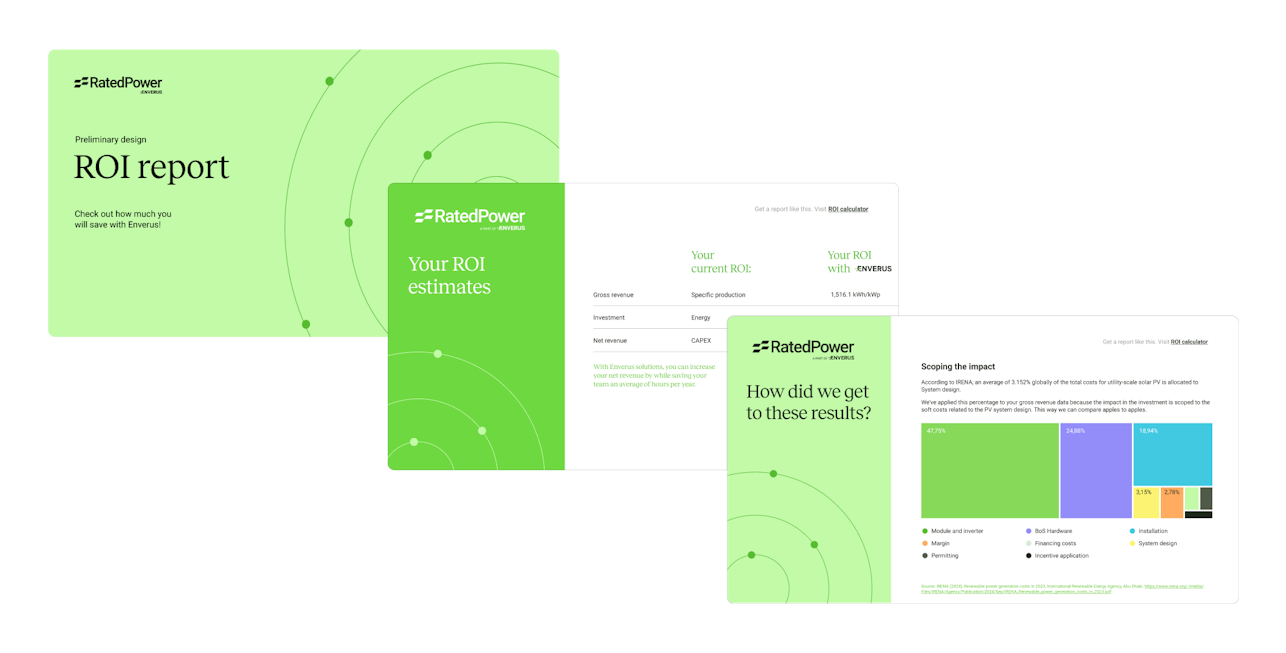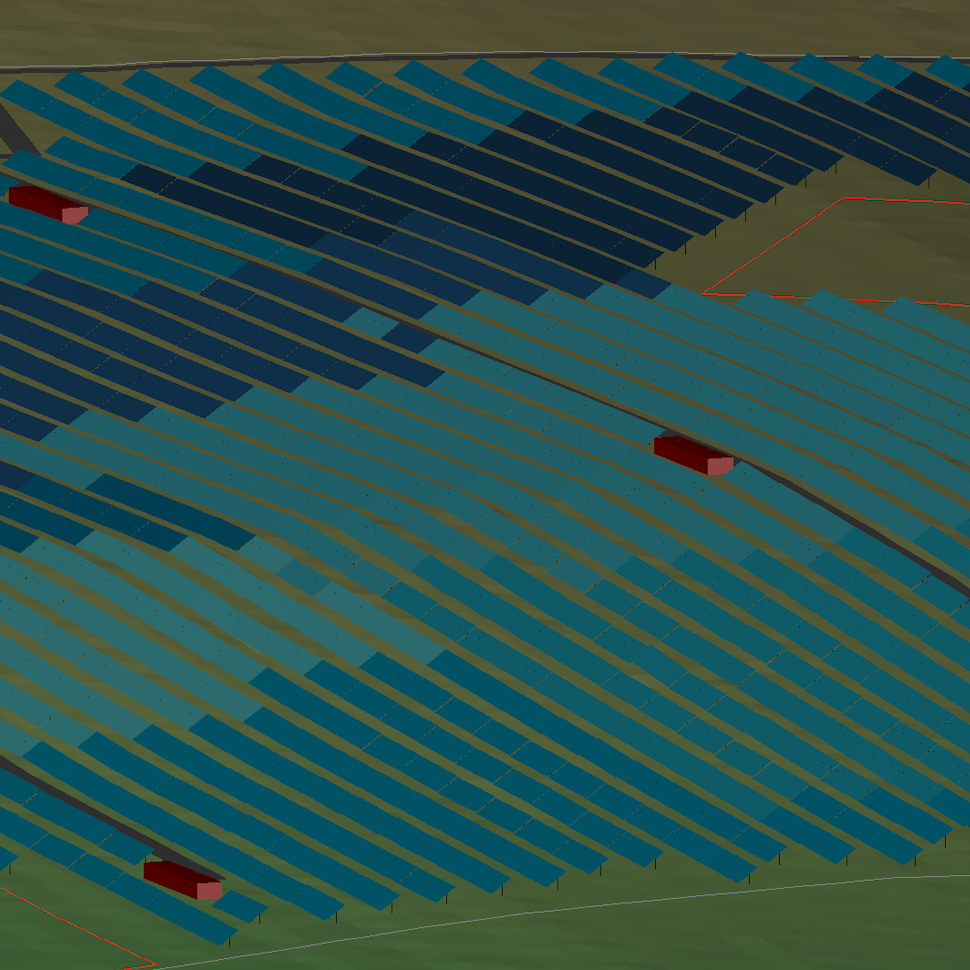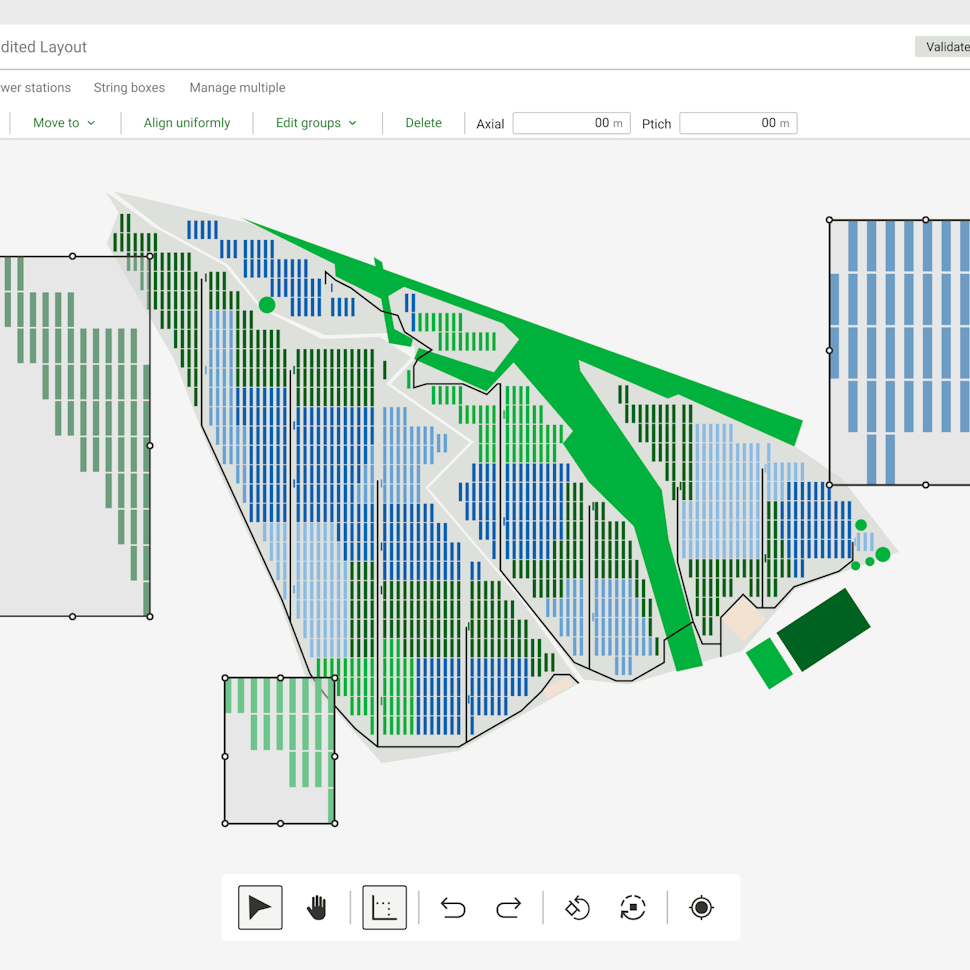- Solar energy blog
- Enverus’ Solar ROI calculator: assess PV plant’s profitability
Enverus’ Solar ROI calculator: assess PV plant’s profitability
Find out how much you could save by integrating Enverus tools into your solar design workflow, as we explain how our solar ROI calculator works.


Pascale Abou Moussa
Product Marketing Manager
Pascale is a marketing expert and Product Marketing Manager at Rated Power. With a background in Neuromarketing, she blends cognitive insights into her strategies. Passionate about understanding the customer needs, Pascale combines her expertise to make impactful contributions to the renewable energy sector.

Content
Design teams in renewables are often under pressure to meet deadlines and strict energy yield targets. You need to optimize layout, choose bankable equipment, and manage permitting and interconnection, often across multiple markets with different technical and regulatory rules. Many factors influence the financial viability and output of solar projects, making it essential to consider all variables.
Every decision affects your project’s financial viability and long-term output. But without a reliable way to measure returns, it’s hard to tell if your choices are helping or costing you. Our calculator helps account for all relevant costs and savings, giving you a clear picture of your return on investment.
Click here to start calculating ROI for your PV, hybrid, and storage from siting to design with RatedPower and to see what Enverus solutions can improve the return of investment of your solar design projects.
Enverus PRISM and RatedPower are built to reduce your design time and software spend to increase overall profitability. Curious to see by how much? Use our new ROI calculator to find out. The calculator provides estimates to help you get an idea of potential savings and shows how the influence of several factors can impact your ROI.
How our ROI calculator works
Our fast and easy-to-use ROI calculator takes your own inputs (staffing expenses, software budget, and project volume) to estimate your project’s ROI, performing calculations based on several key factors that influence the ROI calculation and are accounted for in the assessment. It then runs a comparison to show how Enverus tools could boost it.
You get a side-by-side view of both scenarios with estimated savings in both work hours and dollars. It requires no sensitive project data and provides a decision-ready report you can share with your team.

What you need to get started
To run the calculation, you need to provide a few data points from your current setup:
Number of employees involved in design and development.
Average salaries by role.
Current software expenses.
Annual number of completed projects.
Average revenue per project.
This information helps the tool calculate your current baseline and simulate how it could improve when you start using Enverus software.
What the results include
The calculator returns three key figures:
Your current ROI based on current costs and project income.
Projected ROI after integrating Enverus solutions.
A breakdown of time and cost savings by team role.
With these insights, you can assess whether upgrading to PRISM and RatedPower makes financial sense and where the biggest improvements are likely to come from.
For more tailored advice, consider consulting with an expert after reviewing your calculator results.
How to use the ROI calculator
Step 1: Define the type of design work your team typically handles.
Choose the option that best describes your workflow:
Preliminary design
Preliminary and detailed design
Site prospecting, preliminary, and detailed design
This helps the calculator apply the right assumptions to your team’s workload and where you can integrate Enverus tools for maximum savings.
Step 2: Enter your staffing and software costs.
Indicate your team size and current software spend.
Full-time employees: Enter the number of people on your development team who contribute to project design. This may include roles like project developers, engineers, GIS specialists, and data analysts.
Annual salary per employee: Provide the average yearly salary for each full-time team member working on design and development.
Current tech stack: Add your annual software spend for design-related tools. Make sure this reflects the level of design work you selected in Step 1.
This allows the calculator to build a baseline based on your actual resourcing and workflow.
Step 3: Describe your annual pipeline and revenue.
Annual number of projects: How many utility-scale projects (greater than 1 MW) does your team complete each year?
Revenue per project: What’s the average selling price per project, specifically, the price you typically charge your off-taker?
These figures give the calculator what it needs to estimate your current return and compare it to projected returns with Enverus solutions. For additional context, you can also compare your project data to national averages.
That’s all there is to it!
Understanding Financing Options for Utility-Scale Solar Projects
When planning a utility-scale solar development, understanding the available financing mechanisms is as critical as evaluating site viability, permitting, and system design. The capital-intensive nature of large-scale solar projects requires strategic financial structuring to mitigate risk, attract investors, and ensure long-term profitability.
A range of financing models, such as power purchase agreements (PPAs), tax equity financing, green bonds, and project-level debt, can be leveraged to reduce upfront capital requirements and improve cash flow. Selecting the appropriate financial structure not only influences the project's return on investment but also impacts the long-term operational strategy and ownership model.
Whether you're seeking to optimize capital stack efficiency, secure favorable lending terms, or align with ESG investment criteria, a clear understanding of financing options is essential to the successful development and deployment of utility-scale solar infrastructure.
How Financing Structures Impact ROI in Utility-Scale Solar Development
Financing strategy plays a pivotal role in determining the return on investment (ROI) for utility-scale solar projects. The choice between debt financing, tax equity structures, power purchase agreements (PPAs), or build-own-transfer models directly influences project cash flows, cost of capital, and long-term profitability.
For instance, leveraging tax equity partnerships can significantly improve after-tax returns by monetizing Investment Tax Credits (ITC) and depreciation benefits, while project-level debt can reduce equity requirements but introduce debt service obligations that impact early-stage cash flow. Alternatively, a well-structured PPA with a creditworthy offtaker can enhance bankability and secure predictable revenue streams, improving the project’s risk-adjusted ROI.
By modeling various financing scenarios, taking into account capital stack composition, interest rates, tax treatment, and contractual terms, developers can forecast internal rate of return (IRR), net present value (NPV), and payback period with greater accuracy. Understanding these dynamics is essential for aligning financing decisions with the project's investment goals and operational strategy.
What to expect from the report
Your personalized ROI report will arrive in your inbox within five minutes, in PDF format that’s easy to share and review with your team. Inside, you’ll find:
Your project’s current gross revenue, software spend, and net revenue calculated using your inputs.
A side-by-side comparison with projected revenue using Enverus tools.
Estimated annual time savings based on your team size and workflow.
A clear explanation of how each figure was calculated.
The report shows how Enverus could reduce your software costs, free up design hours, and increase your overall revenue based on your actual inputs. You’ll see where you’re wasting time and what parts of your workflow you’re overspending on.
How we calculate results
First, we calculate your design-related costs. Approximately 3.15% of total costs for utility-scale solar PV projects is allocated to system design, according to IRENA. We apply that percentage to your gross revenue to estimate your current design-related spend.
Next, we use actual performance data from Enverus users to estimate how much time and money you might save when you start using Enverus solutions. We factor in how your team works, what you spend on software, and how many projects you deliver each year to model both scenarios.
How much can you save?
Our tools have been shown to cut time spent on key design tasks by up to 90%. This translates to an annual saving of hundreds of work hours and significant associated labor costs for your team.
Does it take you 50 hours to complete early-stage layout and simulation, for example? You could potentially reduce that to just 5 hours using RatedPower’s automated layout and simulation capabilities.
How Enverus lowers your LCOE
Enverus solutions help your team move faster and reduce overhead, especially during design-heavy stages.
Run fast PV, hybrid, and storage simulations with cloud-based tools.
Reduce design time regardless of your PC hardware.
Access 400+ customizable technical documents, in multiple languages.
Use integrated tools and lower errors from switching between them
Enverus tools help optimize key technical aspects of solar energy systems to maximize solar power production.
Our platform reduces manual work across the renewable project lifecycle, from early simulations to final documentation.
Ready to raise your solar project’s ROI?
Try the self-service guided tour.
Walk through the full design workflow (site selection, layout, and engineering) at your own pace with our interactive tour.
A member of our renewables team will review your setup and suggest practical ways to shorten your design timelines while reducing your software and labor costs, and can provide tailored advice based on your specific project needs, so customers can benefit from personalized recommendations during the demo.
Explore insights and resources.
Visit our blog and resources section for templates, guides, and checklists that other solar professionals rely on to work more efficiently across every stage of a project.
Latest stories
Related posts
Product and corporate updates
Exploring the RatedPower CAD import tool
Discover the RatedPower CAD import tool, an intuitive and time-saving feature that directly integrates DWG CAD files and shapefiles into our platform.
Updated 17 JUN, 25

Product and corporate updates
Discover RatedPower’s Layout Editor
RatedPower’s Layout Editor combines precision, automation, and instant feedback to create a financially and commercially viable layout for a PV plant.
Updated 6 MAY, 25

Product and corporate updates
Renewable energy event PULSE keeps beating in the heart of Madrid
Discover the highlights from PULSE 2025, a leading renewable energy event in Madrid. Explore key insights on solar, storage, AI, and grid innovation shared by top industry experts and innovators.
Updated 9 APR, 25

- RatedPower
- Solar energy blog
- Enverus’ Solar ROI calculator: assess PV plant’s profitability
 Watch a demo
Watch a demo Ask our AI Product Expert
Ask our AI Product Expert